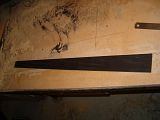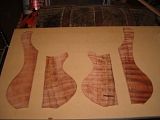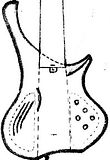
Cerb
-
Posts
113 -
Joined
-
Last visited
Content Type
Profiles
News and Information
Tutorials
Product Reviews
Supplier Listings
Articles
Guitar Of The Month
Links and Resources
Forums
Gallery
Downloads
Posts posted by Cerb
-
-
You wont get any extremely nice pickups for $75 bucks. I'm about to drop a couple hundred on some Nordstand pups. Unless you find some on ebay, about the best you will do is $60 per.
-
I got a few small things finished today. Just click the thumbnails for a larger image.
Fingerboard tapered
15* angle and holes for nut elements of end of fingerboard
Headstock lams glued and clamped
Headstock lams dry with 15* angle
Positions marked on fingerboard
Holes drilled to accept fiber optic cable
Channel routed on the back of the fingerboard for cable
Tomorrow I will probably route the channels for the CF and TR rods and glue up the scarf joint. With any luck, by the end of the week I will have the ebony backplate on the headstock, have the neck tapered and have the headstock shaped.
-
I used crushed azurite from Arizona Silhouette, one of the sites mentioned above, for fretlines on my first bass (search "Concordis" to see how it looks). I'm using turquoise for the one I'm building at the moment (search "syzygy").
-
If it's good enough for Benavente, it's good enough for anybody.
-
Very pretty, dude. I'd hit it (if it was fretless [and maybe if not]
 )
) -
Plus, even without them, I doubt the bass would go out of tune if you had decent tuners. My basses stay tuned within 2 or 3 cents for weeks without retuning.
-
Never do they come out the back of the headstock, though, as he mentioned.
-
Walmouth is another name for Warmoth if you are wondering

-
The only problem I would see would be the holding of the frets well. The string wear is not an issue, because the strings will almost never touch it anyways unless you have a grip from hell.
-
It's not as easy to get away with it if you are playing in a band situation. If you are off a bit it WILL sound dissonant. Playing by yourself isn't really an issue. It won't, however, sound as dissonant on bass for the same ammount of error because of the scale length.
Who said music is supposed to be easy, though? What ever happened to creating challenges for yourself?
-
Not really the "next" level. Pretty much an adjacent level.
I would have to disagree. Playing fretless opens up so many more possibilities for creativeness, technique, etc. One can do amazing things on fretless that you couldn't dream about doing with fretted.
Needless to say, anyone who says it is a bad idea is plain ignorant.
-
Fretless guitars, just as fretless basses add even more creative possibilities. It's hardly a gimmick if you actually wish to take your playing to the next level.
-
String trees are definately not needed with straight headstocks as long as you have a slight step. On my current bass, however, I'm using a 15 degree headstock.
-
They are mainly that large because I'm going for the hollowbody feel, and the body center in wenge, so I need to reduce as much weight as possible. Plus, I hate working in cramped up control cavities. I figure that since the plates will be continuous, it won't really detract from the look. If I wasn't making continuous plates, the cavities would be much smaller.
-
I will be doing my first scarf jointed neck on my current bass project, and I'd hoped to find a good way to do this. This is about as simple as it gets. Thanks tons.
Do you have some type of jig for holding the neck in place while routing the headstock shape. Obviously my neck/headstock combo template that I used for my straight headstock won't work, so I'll need to make a separate template for it. I'm just having troubles picturing how I'm going to rest the neck so that I'm given a level surface for routing the headstock shape.
-
-
Check my Talkbass reply.
-
Other than the coolest word in the dictionary? Yes.

You'd have to see how I'm planning on doing the nut to understand where the name comes from. While designing the nut elements the word popped into my head because of the way they look and the alignment of them, so the name just stuck.
Plus, it's the coolest word in the dictionary!
-
Nice choice of woods and a great original looking design. Normaly I only like very traditional shapes, but this looks great.
That's one thing that I strive for when designing; a nice blend of traditional and modern.
Awesome body design, looks very comfortable for classical style.
I'm hoping that it will be. I don't usually play classical style, but it does help straighten my back, and helps it to not cramp up while playing. The shorter scale will also help with the reach while playing classical style.
Sounds awsome
i thought it would be interesting 2 put padauk and wenge together its a nice contrast.
Wenge and padauk, in that order, are my two favorite woods. On my last bass I used a padauk headstock backplate on a wenge neck. Not only do they look great alone, but they look even better together
 .
. -
I will start this thread off in this manner...
Disclaimer: Work shown herein may or may not be finished in a timely manner. Nothing but the top wood has been bought, and therefore I need time to gather stuff. Thank you for your cooperation.
Here is the original sketch:
Specs:
- 4 string Fretless
- Turquoise fretlines
- Semi-Hollow
- 32 1/2" Scale
- Continuous cavity covers
- Inlayed straplocks
- Angled headstock
- Singular adjustable string holders rather than a nut
- Fiber optic side markers
- Lotus inlay on back of bass
- Nitro Lacquer
Wood:
- Wenge neckthrough with padauk at body
- Flamed redwood, Padauk, Walnut, Wenge, Walnut, Padauk, Flamed Redwood wings
- Gaboon Ebony Fingerboard
Hardware:
- All black
- ETS MK III headless bridge
- Duesenberg string clamps
- Wooden Knobs
Electronics:
- Aguilar OBP-3
- Nordstand DC pups
THE PROGRESS SHOTS CAN BE SEEN HERE
-
I don't like eruption, but this is beautiful! I will, however, say that you should go with fretless. The little metal speedbumps always divert your eyes from the rest of the basses beauty. Very, very cool though, dude
-
Drill presses definately have enough strength to press the frets. I haven't done it myself, but I've seen it done quite enough.
-
Just find a straight on strat picture. Resize and print. Then simply print it on multiple pages, tape them together, and cut it out. Works perfect...
-
I'm really enjoying these pups. They have a great slap tone if you boost the bass and treble a bit and totally boost mids. At least, that's the setting I use for this bass. I'm not much of a slapper, though, so my tastes may not be quite as refined as some.
The controls along the bottom are, from back to front, bass, mid, and treble. The mid has a push-pull frequency selector of 250 or 800hz. The 2 knobs above that are just blend and volume, with an active/passive push-pull on the volume.
It's funny how little things really make a difference, but one of my favorite thing about the electronics is simply that I mounted the output on the front rather than the side. That's definately how I will continue to do it in the future.




Project Syzygy
in In Progress and Finished Work
Posted · Edited by Cerb
The scarf joint turned out perfect. I'm very pleased with the results, being as it is my first and I was quite worried about it. Here it is after cleaning it up:
I finished all of the work on the fingerboard as well. Here is is after radiusing to 10" and cutting an access hole for truss rod adjustment:
http://img.photobucket.com/albums/v375/Cer...Progress/21.jpg